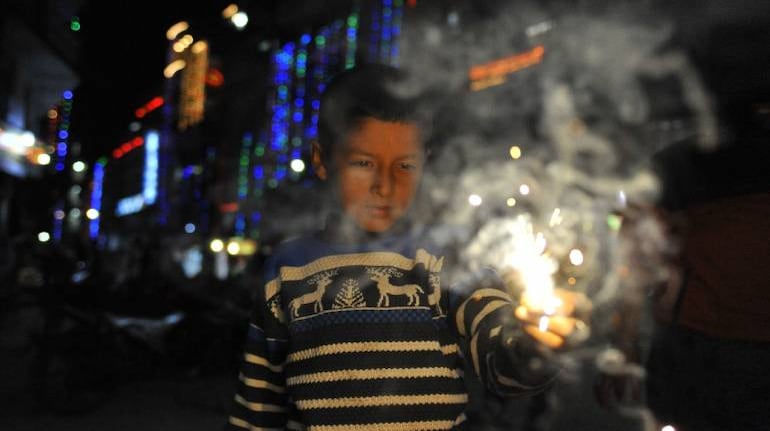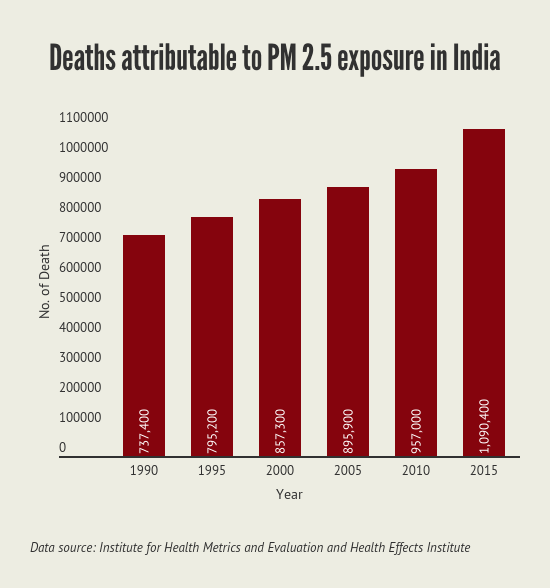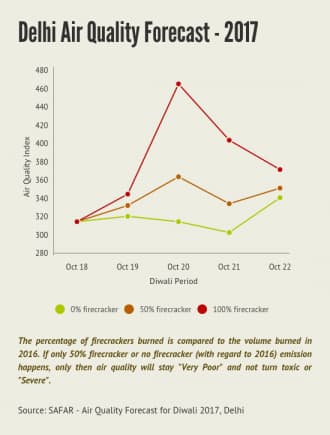



Bursting firecrackers is joyful, but little does one know how hazardous the smoke emitted from them can be. For example, a string of 1,000 crackers, popularly known as 'laad', can be as dangerous as smoking over 270 cigarettes.
The black-coloured pellet, which spews out a 'snake', when lit can be as harmful inhaling smoke from as 464 cigarettes, according to calculations done by IndiaSpend.
The Methodology
Burning crackers and cigarettes produces particulate matter of PM2.5 concentration — a health hazard.
A significant study by Chest Research Foundation (CRF) shows the level of pollution caused by burning a few firecrackers. The CRF team monitored and measured personal exposure levels to PM 2.5 with respect to the burning of six most common firecrackers — fuljhadi, chakri, flower pots, pulpuls or string-shaped sparklers, laad and snake pellets.
Among the six, snake pellets generated the highest level of PM2.5 at 64,500 mcg per cubic metre of air space during a small span of burning. It was followed by laad which reached the level of 38,540 mcg per cubic metre.
 Source: ERS Journal
Source: ERS Journal
Now, in an enclosed space, the PM 2.5 generation from cigarette smoke is 139 mcg/m3, according to a research published by Tumori Journal.
Thus, in smoke equivalent, burning a laad (PM2.5 = 38,540 mcg/m3) is as bad as lighting up 277 cigarettes (PM 2.5 = 139 mcg/m3).
One pulpul or a string-shaped sparkler when lit leads to smoke which is equivalent to smoking 208 cigarettes, fuljhadi emits smoke that means lighting up 74 cigarettes, Chakri or ground spinners - 68 and a flower pot or Anaar leads to smoke that is equal to the smoke emitted by close to 35 cigarettes. All this, quite alarmingly, happens within 2-6 minutes if one unit of each firecracker is lighted at once.
As per Central Pollution Control Board (CPCB) standards, the 24-hour mean of PM2.5 concentration should not cross 60 mcg/m3. The WHO standards are even lower at 25 mcg/m3.
“Fine particles on their own or with combination with other air pollutants are linked with a number of health problems like premature death, aggravated asthma, acute respiratory symptoms including aggravated coughing and difficult or painful breathing, chronic bronchitis and decreased lung function,” says a medical study facilitated by CPCB.
Exposure to PM2.5 led to over a million deaths in India, according to data from the State of Global Air 2017, a project by Institute for Health Metrics and Evaluation in collaboration with the Global Burden of Disease project.

Around 1.4 million people died in India due to diseases caused by air pollution in 2013, according to a 2016 study.
Delhi - The Smog Capital
The Supreme Court of India has banned the sale of firecrackers in Delhi-NCR during Diwali owing to previous instances of pollution level soaring up to toxic levels during the festive season.
Delhi is one of the worst affected cities by such air pollution.
As per a recent forecast by SAFAR (System of Air Quality and Weather Forecasting And Research), a pollution monitoring group, Delhi's air quality will remain 'very poor' even if 50 percent lesser firecrackers are burnt compared to last year. If the level of firecrackers burnt stays the same, the air quality will turn 'severe'.

'Very poor' air quality means that people may suffer from respiratory illness after exposure to such air for a significant period of time.
Another study suggests that people in India's capital can live nine years longer if the country meets the WHO's air quality standards. The Air Quality-Life Index (AQLI) report by the Energy Policy Institute at the University of Chicago (EPIC) suggests that if India meets the national Air Quality Standards or WHO standards for PM2.5–particulate matter less than 2.5 microns in size, several cities would gain in terms of life expectancy.
Among all of India's cities, Delhi's citizens would be the biggest beneficiaries if the city adheres to the WHO prescribed air quality norms. The people of Kolkata and Mumbai could live roughly 3.5 years longer if the country met WHO standards. Overall, Indian citizens could live four years longer if India meets WHO standards, the report states.
To find more about the report findings head to — DATA STORY: Living in Delhi can cut 9 years of your life
Is it really that bad?
“The concentration of PM10 was very high during Diwali as compared to the normal days and the day before Diwali,” states a 2014 study conducted by Chirag Verma and Dhananjay K Deshmukh from National Institute of Technology, Raipur and Hokkaido University, Japan respectively. The concentration of PM10 was 507 mcg/m3 in Delhi, 753 mcg/m3 in Lucknow and 930 mcg/m3 in Nagpur.
Higher values of iron, barium and copper are found in the ambient air during Diwali as these are used for creating colourful fireworks while zinc is used for the smoke effects, according to the study.
Firecrackers, which generally contain 75 percent potassium nitrate, 15 percent carbon and 10 percent sulphur, release toxic gases such as carbon dioxide, sulphur dioxides and nitrogen dioxide, the research shows. Sulphur dioxide is “more toxic because they slowly get absorbed in the fine particles and are transported deep into the lungs”, damaging the tracheal nasal system, the study states.
Discover the latest Business News, Sensex, and Nifty updates. Obtain Personal Finance insights, tax queries, and expert opinions on Moneycontrol or download the Moneycontrol App to stay updated!
Find the best of Al News in one place, specially curated for you every weekend.
Stay on top of the latest tech trends and biggest startup news.